Mercedes-Benz Citaro
| Mercedes-Benz Citaro | |
|---|---|
_Qbuzz.jpg) | |
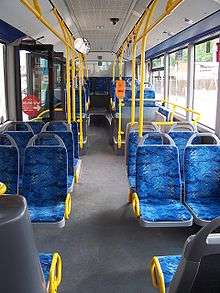 | |
| Overview | |
| Manufacturer | Mercedes-Benz |
| Production | 1997–present |
| Body and chassis | |
| Class | Complete bus |
| Doors | 1, 2, 3, 4 or 5 |
| Floor type |
Low floor Low entry |
| Powertrain | |
| Engine |
Mercedes-Benz OM457LA OM457hLA OM906hLA OM926LA M447hLAG OM936 OM936h OM470 |
| Transmission | automatic, depends on the generation |
| Dimensions | |
| Length |
11,950 millimetres (470 in)(Citaro) 14,500 millimetres (570 in)(Citaro L) 17,990 millimetres (708 in)(Citaro G WMB variant) 18,125 millimetres (713.6 in)(Citaro G NMB variant) 19,675 millimetres (774.6 in)(CapaCity and UAE ambulance bus) 20,995 millimetres (826.6 in)(Capacity L) |
| Width | 2,550 millimetres (100 in) |
| Height | min.3,170 millimetres (125 in) |
| Curb weight | min.10t |
| Chronology | |
| Predecessor |
Mercedes-Benz O405 Mercedes-Benz O405N |
The Mercedes-Benz Citaro (or O530(G)) is a single-decker bus / articulated bus manufactured by Mercedes-Benz/EvoBus. It was introduced in 1997 and replaced the Mercedes-Benz O405/O405N series. Manufactured in Mannheim (Germany), Ligny-en-Barrois (France) and Sámano (Spain), it is available as a rigid bus with two or three axles and as an articulated bus with three or four axles. Over 40,000 have been manufactured.[1]
Models
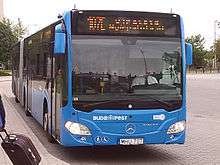
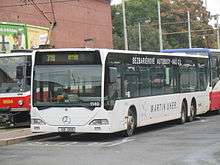
Urban model
The standard urban model is available in a number of versions:
- O530: solo bus, length 12 m, 2 axles, horizontal or vertical engine, 2 or 3 doors, even with front door only (in countries with left-hand traffic)
- O530 CNG: gas drive, length 12m, 2 axles, 2 doors
- O530 FuelCell Hybrid, length 12m, 2 axles, 3 doors
- O530G: articulated bus, length 18m, 3 axles, horizontal or vertical engine, 3 or 4 doors, also with 2 doors only (in countries with left-hand traffic)
- O530G BlueTec Hybrid, length 18m, 3 axles, 3 or 4 doors
- O530G CNG: articulated bus with gas drive, length 18m, 3 axles, 3 doors
- O530 GL: articulated bus (long) (CapaCity), length 19.5m, 4 axles, 3 or 4 doors
- O530 GL II: articulated bus (long) (CapaCity L), length 21.0m, 4 axles, 4 or 5 doors (metro package)
- O530 K: Midibus, length 10.5m, 2 axles, lying engine underfloor in the rear, 2 (also 3) doors
- O530 L: solo bus (long), length 15m, 3 axles, 2 or 3 doors
- O530 LE: Low Entry, length 12m, 2 axles, 2 or 3 doors
Suburban/interurban model
A series of suburban/interurban versions is also produced, with all seats fitted on platforms:
- O530 GÜ: articulated bus, length 18m, 3 axles, 3 or 4 doors
- O530 LE MÜ: low-entry (medium length), length 13m, 2 axles, 2 or 3 doors, even with front door only (in countries with left-hand traffic)
- O530 LE Ü: Low-Entry, length 12m, 2 axles, 2 or 3 doors
- O530 LÜ: solo bus (long), length 15m, 3 axles, 2 or 3 doors
- O530 MÜ: Solo bus (medium length), length 13m, 2 axles, 2 doors
- O530 Ü: solo bus, length 12m, 2 axles, 2 or 3 doors
Specifications
Operators are able to choose between two different front stylings: the standard design features an angled destination display, like a roof dome, and is primarily marketed for urban buses, while a version with a one-piece windscreen covering the destination display also is available and is primarily intended for interurban use. However, all models are available with either version.
Other customizations include the number and type of doors as well as the internal layout. Two types of seats are offered as part of the standard range, again with a basic model for urban use and an enhanced version for longer-distance routes, although both also are available on all models.
Aside from the usual diesel engines, the Citaro is also available with a powerful Euro IV natural gas engine (model M 447 hLAG) rated at 185 kW (252 PS) or 240 kW (326 PS) - the latter rating used mainly for interurban and articulated buses or standard-length city buses operating in areas with a hilly topography. These engines are also optionally available with Enhanced Environmentally friendly Vehicle (EEV) certification, meaning that their emission levels are lower than even the most stringent European Union emissions standards.
History
The first generation Citaro was launched in 1997. In 2002, Citaro updated the first small facelift after production ends on the Mercedes-Benz O405. Externally, it differed in the now straight back side window line, the radiator flap was lowered and increased the air intake. Previously, the last side windows and the radiator grille underneath had a kink rising to the rear window. It was hoped that with the change in air intake, the thermal problems, up to the multiple unexplained vehicle fires of this series to get a handle. In the context of this facelift also the previously used rigid front axle was replaced by a used also in the subsequent low-entry vehicle independent suspension, whereby the ride and suspension comfort was increased. The axle originally came from ZF Passau and was revised by Daimler-Benz.
In 2005, EvoBus launched an updated version of the Citaro to coincide with the introduction of Euro IV-(and later Euro V- and EEV-)compliant engines. Apart from minor technical alterations, mainly to accommodate the new generation of engines, the external design received a facelift to give the buses a less angular look, with internal panelling altered accordingly. Production of the old model ceased by autumn 2006. The Citaro LE and Citaro LE Ü models, which were introduced at the same time, were never produced to the old design.
In the summer of 2006, there was a bigger facelift to the existing variant, which can be seen from the outside by a revised front and rear design (analogous to the recently introduced low-entry buses). The hitherto characteristic feature of the first series, the "washboard trim" on the front of the vehicle, which was also available as a front advertising area and smooth surface without Mercedes star, accounted for a somewhat rounded front baffle. The lateral sweep of the front turn signals was reversed. The rear was adapted to the coach Travego: it got similar multi-chamber lights and was designed a whole rounder. This can be made possible through the orders of Singapore buses since January 2011.
In May 2011, the second generation Citaro, internally known as the C2, was launched.[2] From 2012 the C2 could also be equipped with Euro 6 engines. The C2 versions of the Citaro LE models were the last to be presented, at Busworld Kortrijk in October 2013.[3]
While the Citaro C2 solo bus is produced as standard with the horizontal Euro 6 diesel engine OM 936h, the Citaro C2 G articulated bus will be equipped with the stationary OM 470 engine as standard. The C2 articulated bus with a horizontal engine OM 936h was also presented at the IAA 2014 in Hanover. Since fall 2015, this is delivered to customers.
From 2018, Mercedes-Benz will also mass-produce the Citaro as an electric bus called the Citaro E-CELL and the fuel cell bus Citaro F-CELL.
Non-standard bodies
As a one-off, German operators üstra of Hanover and LVB of Leipzig took delivery of a batch of Citaros bodied to a special design by James Irvine for Expo 2000. Leipzig's vehicles were lent to Hanover for the duration of the exhibition, but subsequently returned to normal service in their home city. All other Citaros bodied by Mercedes-Benz were to standard designs, however a number of chassis were bodied by independent manufacturers, most notably Hess of Switzerland. However, the Citaro has more recently only been sold as a complete product.
In 2007 the workshops of the Szeged (Hungary) bus operator SZKT converted a regular Citaro to a trolleybus. As of April 2010, five such buses are already serving as a trolley and more examples are in preparation in the near future.[4]
In 2009, the Centre of Ambulance Services in Dubai took delivery of three Citaros, which had been modified to become the world's largest ambulances.
In 2010, the French city Rennes ordered a longer version of the Citaro, the Citaro M, which is 13 meters long with an urban arrangement. 15 vehicles were built over the chassis of the Setra S416NF.
Hydrogen fuel cell version
Even though the usual Citaro models are powered by diesel or natural gas, there is also a hydrogen fuel cell-powered version, designated Citaro BZ or O530BZ. About 35 of these buses have been in service in a variety of different world cities in order to test the feasibility of hydrogen fuel cells in different operating circumstances and different conditions, especially weather conditions.
Hybrid electric version
The Mercedes-Benz Citaro G BlueTec Hybrid is a series-hybrid articulated bus with a compact 450 kg, 4-cylinder, 4.8-litre, 160 kW, Euro 4 OM-924LA diesel engine providing power for a roof-mounted 19.4 kWh lithium-ion battery pack, and four 80 kW electric wheel hub motors located on the centre and rear axles. (Contrast a conventional bus diesel engine: 6-cylinder, 12-litre, 1,000 kg.) The battery pack is also charged by regenerative braking (recuperation). The manufacturer anticipates fuel consumption 20% lower than conventional diesel Citaros. [5][6][7] In 2010, selected bendy buses were delivered in hybrid version to Wuppertal, Stuttgart, Krefeld, Hamburg and Mülheim. Other buses were also delivered to Essen, Duisberg, Munich, Mainz, Hamburg and Rostock are also in the rigid versions. The Dresden and Leipzig also delivered their Citaro hybrid buses in 2011.[8]
Battery version
Since 2015, Aachen Transport runs a battery-powered Citaro articulated bus as a test in scheduled operation. The vehicle was converted in 2014 from a hybrid bus to a battery bus. They removed all diesel components and installed 1300 traction batteries with a total capacity of approximately 180 kWh. The axle loads remained unchanged. The vehicle has four wheel hub motors with 60 kW continuous power on the second and third axle and has a range of more than 50 kilometers. The conversion was carried out as part of the EU project Civitas (Cleaner and better transport in cities) and was funded by the Aachen Transport Association to 75 percent. The costs for the hardware (eg batteries) amounted to approximately 700,000 euros.
Mercedes-Benz is currently testing prototypes of the Citaro with all-electric drive. The bus will feature a modular battery pack design and use the same electric wheel hub motors as the Citaro G BlueTec Hybrid. It is scheduled for presentation at the IAA Commercial Vehicles show in Hanover in September 2018.[9]
Overhead wire version
Because EvoBus itself does not offer trolleybuses, the transport companies of the Hungarian city of Szeged independently built six second-hand Citaro solo cars into trolleybuses between 2006 and 2010. This is expected to save on spare parts inventory - this can be done together with the same diesel buses of the dispenser series - as well as lower acquisition costs compared to standard production trolleybuses. The modified type designation is O-530 Tr12, the six wagons bear the operating numbers T-860 to T-865.
In 2012, two Citaro trolleybuses also went into operation in Polish Gdynia. The cars with the numbers 3053 and 3054 originated from used acquired diesel buses from Berlin, which has been delivered in 2002.
Operators
Europe
United Kingdom
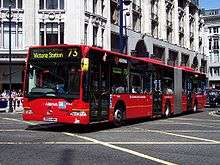
Arriva, FirstGroup, Go-Ahead Group, Stagecoach Group, Yourbus and McGill's Bus Services have all operated Citaros. Articulated Citaros were operated by Transport for London operators East London, First London, London Central, London General, London United, Quality Line and Selkent.[10][11]
In 2003 and 2004, four buses caught fire, although there were no casualties involved. One was burnt on its delivery journey. Mercedes-Benz did address the problem, though the buses were withdrawn for some time that saw the brief return of the just-retired AEC Routemasters. Unfortunately, these buses were said to have marred the reputation of articulated buses in the United Kingdom, and some Londoners nicknamed them Chariots of Fire.[12]
The last articulated buses in London were withdrawn in December 2011.[13] Some examples ended up in Malta as Arriva took over bus services there. Some rigid 12 metre examples remain in service with Go-Ahead London on routes 108 and 358. There also some in use with other operators on suburban routes including London United on route 203 and Stagecoach Selkent on route 227. Epsom Buses will use Citaro K buses when they take over route 413 from Go-Ahead London on December 4, 2016.
Since 2013 Cardiff Bus has operated citaros. They are numbered 101-120 original design and 121 to 140 are the C2 design. 117 to 120 operate on the X59 park and ride service and the newest 2017 131 to 140 are fully branded for the 27 Thornhill service replacing 10 year old scania omnicity. Cardiff bus currently operate 40 citaros.
Solent Blue Line in Southampton received 10 Citaros in 2006. They were branded in the Bluestar livery and were mostly seen on the services 8 and 9 to Hythe and the waterside. Others could be seen in the colours of sister companies in the Go-Ahead group such as Uni-Link, Southern Vectis and Wilts and Dorset including the 'Pulse Line' (Salisbury) and 'More' (Bournemouth and Poole) branded services.
Germany
The Hamburger Hochbahn operates the Citaro since 1997 and ordered over 1000 over the time.[14] The BVG has operated about 450 Citaros.[15]
Hungary
In Hungary, VT-Arriva purchased 159 to operate services in Budapest for BKK.[16][17][18]
The Netherlands
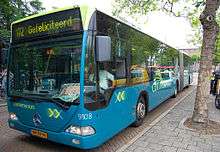
In 2009, Qbuzz ordered 350 while Connexxion ordered 75.[19]
Romania
Between 2005 and 2009 Regia Autonomă de Transport București purchased 1,000 Citaros.[20]
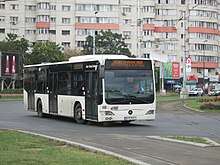
Middle East
By 2009, 180 Citaros had been delivered to the city of Al Ain.[21]
Latin America
In Latin America, Citaros are not present in large quantities in public transport systems. Only Mexico has 14 Spanish-built Citaros for the BRT Internal System of UNAM.
Asia
Japan
In 2010, Keisei Bus ordered 15 articulated Citaro G buses, primarily for service in east Tokyo.[22]
Singapore
SBS Transit and SMRT Buses have purchased 351 Euro V Citaro single-decker buses in 2010, then jumped to 474 in 2012 and a further 330 in 2014.[23][24][25] By 2017, Singapore would have more than 1,400 buses in operation, under SBS Transit, SMRT Buses, Tower Transit Singapore and Go-Ahead Singapore.[26][27]
Oceania
Australia
In Australia, between September 2004 and September 2007, Transperth operated three hydrogen powered Citaros.[28][29] In 2016, Brisbane Transport commenced operating a Citaro demonstrator.[30][31]
Gallery
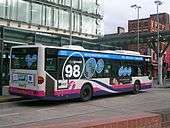 Rear of an early First Greater Manchester Citaro, showing the slightly different engine grille on the first Citaros
Rear of an early First Greater Manchester Citaro, showing the slightly different engine grille on the first Citaros- Rear view of the more standard rear styling on a 2006 Arriva Southern Counties Citaro
References
- ↑ "40,000 Mercedes-Benz Citaro models and 20,000 Mercedes-Benz minibuses". Daimler. 16 April 2014. Retrieved 21 August 2015.
- ↑ "Die Entwicklung steckt im Detail" [The development is in the details]. Der Rote Renner (in German). 20 May 2011. Retrieved 21 August 2015.
- ↑ "Daimler Buses at Busworld 2013". Daimler. 4 September 2013. Retrieved 21 August 2015.
- ↑ YouTube: Mercedes-Benz Citaro trolley in Szeged. Retrieved on 31 October 2007.
- ↑ "Mercedes-Benz Citaro G Bluetec Hybrid Bus Given 2008 DEKRA Environmental Award". Green Car Congress. 2008-01-31. Retrieved 2009-02-23.
- ↑ Michael Graham Richard (2008-01-31). "Citaro Hybrid Bus Wins 2008 DEKRA Environmental Award". Treehugger. Retrieved 2009-02-23.
- ↑ "The 2008 DEKRA environmental award - The Citaro G Blue Tec Hybrid bus". Mercedes-Benz - Omnibus News. 2008. Retrieved 2009-02-23.
- ↑ "Bundesverkehrsminister übergibt Hybridbusse an Leipzig" [Federal Traffic Minister gives hybridbus to Leipzig]. . Auf Leipzig Info, 27 May 2011. Citaro hybrid buses also drive at the Mainz transport company and other German transport companies.
- ↑ "Electric mobility: Emission-free through the city: the countdown to the Mercedes-Benz Citaro with all-electric drive has begun | marsMediaSite". marsMediaSite. Retrieved 2017-11-10.
- ↑ Mercedes-Benz O530 Bus Lists on the Web
- ↑ Mercedes-Benz O530G Bus Lists on the Web
- ↑ New bendy bus blaze scare London Evening Standard 2 October 2007
- ↑ Bendy bus makes final journey for Transport for London BBC News 10 December 2011
- ↑ "Mercedes-Benz Citaro für Hamburger Hochbahn: Seit über 15 Jahren fährt der Citaro in Hamburg" (in German). Retrieved 14 April 2018.
- ↑ "Die Omnibusflotte der BVG" (in German).
- ↑ Budapest orders biggest fleet to date of new Mercedes-Benz Citaro urban bus Busworld 10 December 2012
- ↑ First Mercedes-Benz Citaro buses delivered to Budapest Budapest Business Journal 2 May 2013
- ↑ "Járműpark" (in Hungarian). VT-Arriva. Retrieved 25 April 2017.
- ↑ Mercedes-Benz receives two major orders Mercedes-Benz
- ↑ Daimler Buses delivers 1,000th Mercedes-Benz Citaro to Romania Daimler 9 July 2009
- ↑ 100 Mercedes-Benz Citaro buses Abu Dhabi Archived 2016-04-15 at the Wayback Machine. Mercdes-Benz
- ↑ "Best-selling Citaro Now Also Used by Keisei Bus in Japan". Daimler Global Media Site. Retrieved 28 April 2018.
- ↑ Major order from Singapore Daimler 21 April 2011
- ↑ 300 Mercedes-Benz Citaro City Buses to Singapore Busworld 7 May 2011
- ↑ Singapore: Mercedes wins follow on Citaro order Automotive World 19 July 2012
- ↑ SBS to complete fleet renewal by 2017 Archived 2016-04-14 at the Wayback Machine. Asia One Transport 2 July 2014
- ↑ SBS Transit to Add 665 More Buses SBS Transit 2 July 2014
- ↑ Sustainable Transport Energy Project Archived 2016-02-27 at the Wayback Machine. Global Hydrogen Bus Platform
- ↑ EcoBus Archived 2016-04-13 at the Wayback Machine. Department of Transport
- ↑ Chassis: 2016 Supplier Outlook Australian Bus & Coach 8 February 2016
- ↑ Video Review: Mercedes-Benz Citaro Australasian Bus & Coach 10 March 2016
External links
| Wikimedia Commons has media related to Mercedes-Benz Citaro. |
- EvoBus
- Mercedes-Benz/EvoBus Citaro page
- Mercedes-Benz/EvoBus Citaro G page
- Paumgarten, Nick (2008-05-26). "Ich Bin Ein M4". New Yorker. Retrieved 2008-05-24.

